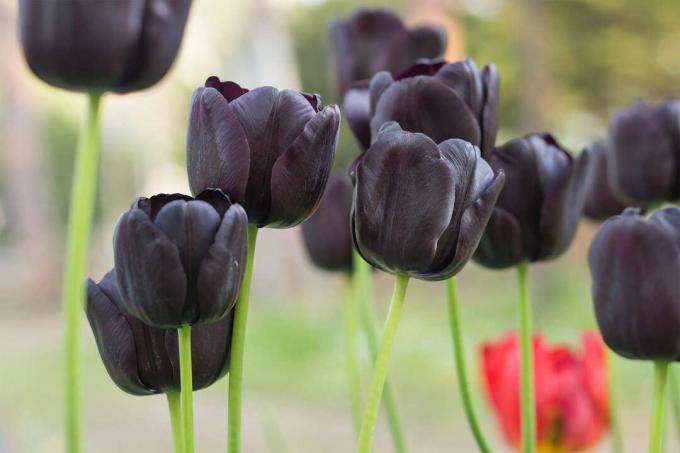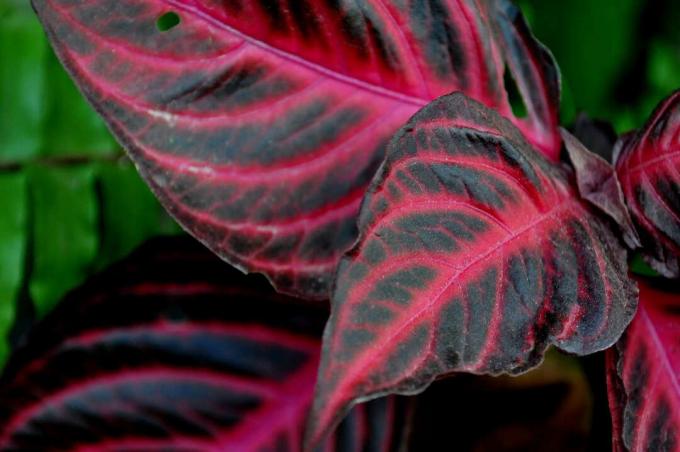You see black on these plants - and rightly so! We'll show you ten black beauties for more drama in your garden.

Yellow, purple, red - when we think of flowers, bright, bright colors pop through our minds. There is also the exact opposite: black plants are not only something special, they also add a mysterious and dramatic touch to your garden. With these ten black plants, your garden will become a very special eye-catcher.
contents
- 10. The petunia
- 9. tulip
- 8. Black Head
- 7. Colored nettle
- 6. violet
- 5. Indian flower tube
- 4. mallow
- 3. Zantedeschien
- 2. Black snake beard
- 1. Spring roses
10. The petunia
Petunias are bright and colorful? This may apply to many representatives of the variety, but not to the "Black Velvet". It is the first black petunia variety on the market and immediately enchants with its black, almost velvety-looking flowers. No wonder it has become a popular potted plant. But the petunia can also be grown wonderfully in the garden. It makes the same demands as its colorful sisters and brings a wonderful contrast to the other brightly colored flowers. Meanwhile, the "Black Velvet" is no longer the only black representative of its kind, but it remains the best-known.

9. tulip
The black one tulip is not just a movie. The Amsterdam flowers also have black offshoots. Above all, the "Queen of the night" enchants with such a dark Bordeaux shade that it almost looks black. Like most tulips, it is very easy to care for and has no special requirements. The black tulip is particularly suitable for beginners who still want a little something extra in their garden.

8. Black Head
Even if you first think of a famous hair care company, the Schwarzkopf is actually a plant. And this lives up to its name with its dark red to black foliage. as Succulent plant, or rose leaf, it is particularly suitable as a potted plant and is considered easy to care for and robust. Due to the weather, it is less suitable for the garden, after all, the desert plant likes it warm and does not tolerate the German winter well. Another highlight of this great plant: The Schwarzkopf flowers are not black, but bright yellow.

7. Colored nettle
Although the name suggests otherwise, the colored nettle can also come up with some black varieties. "Dark Star" or "Black Prince" not only sound noble, but also leave a lasting impression with their dark red, almost black color. In the garden, nettles are easy to care for as an annual plant; in pots, protected from the weather, they can also thrive for several years. Their color is much more intense in the sun than, for example, in penumbra.

6. violet
Roses are red, violets are black? In fact, the timeless flowers are also available in a dark variation. Varieties like "Molly Sanderson" combine the classic among flowers with what is probably the most classic color: black. Despite its black color, the "Molly Sanderson" is otherwise a typical violet. Not only is it quite undemanding, it also pampers the gardener's nose with the typical violet scent - a pleasure for all the senses.

5. Indian flower tube
The Indian flower tube is probably one of the exotic species in the garden world. But it becomes even more unusual if you also opt for a black variation of the tall plant. While the leaves are dark red to black in color, the flowers shine in a strong red - pure drama. In a sheltered, sunny place, the flower tube feels at home in German gardens as well. The only thing is that the exotic plant cannot tolerate winter very well and should therefore spend it indoors.

4. mallow
Mallows are one of the beauties in the flowerbed anyway. But if they also bloom with black flowers, their sight is really breathtaking. The dark brown to black petals form a wonderful contrast to the otherwise very green stems and leaves of the plant. Mallow can also be grown in a sunny spot in German gardens.

3. Zantedeschien
Zantedeschien or "calla lilies" actually come from the tropical areas in southern Africa With the right care, they can also be found in German gardens when they spend the winter indoors to be allowed to. Calla has also proven itself as a houseplant and brings an exotic flair to your home. Their dark purple, almost black variants look particularly exciting. Zantedeschien like the "Black Star" then form a nice contrast between the dark bract and light green stems and the other leaves.

2. Black snake beard
Like from another planet - Black Snake Beard has its own charm. The plant, which comes from Japan, does not look particularly good at first with its grass-like foliage spectacular if it weren't for its color: the leaves, stems and fruits of the Asian plant are complete colored black. The snake's beard is a bit more demanding in handling and needs regular care. On the other hand, it can be used to set wonderfully dark accents in the garden.

1. Spring roses
Even if the spring rose does not match its namesake the rose is related, it is in no way inferior to it in terms of beauty. The “Midnight Ruffles” variety in particular impresses not only with its dark purple flower color and velvety appearance. It also has almost three times as many petals as its colored sisters. In the garden, the spring rose is less demanding than the Christmas rose, for example. Another advantage: the flowers can be seen from February, making them one of the first to flower in the new year.

If you are interested in other black plants, you can find information about here black tomatoes.
